Lingam
A Shiva lingam with tripundra
| Part of a series on |
| Shaivism |
|---|
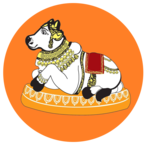 |
Lingam is additionally found in Sanskrit texts with the meaning of "evidence, proof" of God and God's existence.[1][7][8] Lingam iconography found at archaeological sites of the Indian subcontinent and southeast Asia includes simple cylinders set inside a yoni, rounded pillars with carvings such as of one or more mukha (faces), and anatomically realistic representations of a phallus such
Nomenclature and significance
Lingam as interpreted in Shaiva Siddhanta tradition which is a major school of Shaivism. Upper and lower part represents Parashiva and Parashakti perfections of Lord Shiva.
The lingam of the Shaivism tradition is a short cylindrical pillar-like symbol of Shiva, made of stone, metal, gem, wood, clay or disposable material.[1][17] According to Encyclopædia Britannica, the lingam is a votary aniconic object found in the sanctum of Shiva temples and private shrines that symbolizes Shiva and is "revered as an emblem of generative power".[1] It often is found within a lipped, disked structure that is an emblem of goddess Shakti and this is called the yoni. Together they symbolize the union of the feminine and the masculine principles, and "the totality of all existence", states Encyclopædia Britannica.[1]
According to Rohit Dasgupta, the lingam symbolizes Shiva in Hinduism, and it is also a phallic symbol.[16] Since the 19th-century, states Dasgupta, the popular literature has represented the lingam as the male sex organ. This view contrasts with the traditional abstract values they represent in Shaivism wherein the lingam-yoni connote the masculine and feminine principles in the entirety of creation and all existence.[16] According to Wendy Doniger, for many Hindus, the lingam is not a "male sexual organ" but of a spiritual icon and their faith, just like for the Christians the cross is not an "instrument of execution" but a symbol of Christ and the Christian faith.[14][note 1]
According to Alex Wayman, given the Shaiva philosophical texts and spiritual interpretations, various works on Shaivism by some Indian authors "deny that the linga is a phallus".[12] To the Shaivites, a linga is neither a phallus nor do they practice the worship of erotic penis-vulva, rather the linga-yoni is a symbol of cosmic mysteries, the creative powers and the metaphor for the spiritual truths of their faith.[19]
According to Sivaya Subramuniyaswami, the lingam signifies three perfections of Shiva.[20][better source needed] The upper oval part of the Shivalingam represent Parashiva and lower part of the Shivalingam called the pitha represents Parashakti.[21][better source needed] In Parashiva perfection, Shiva is the absolute reality, the timeless, formless and spaceless. In Parashakti perfection, Shiva is all-pervasive, pure consciousness, power and primal substance of all that exists and it has form unlike Parashiva which is formless.[22][better source needed]
History
According to Nagendra Singh, some believe linga-worship was a feature of indigenous Indian religion.[23]Archaeology and Indus valley
According to Chakrabarti, "some of the stones found in Mohenjodaro are unmistakably phallic stones". These are dated to some time before 2300 BCE. Similarly, states Chakrabarti, the Kalibangan site of Harappa has a small terracotta representation that "would undoubtedly be considered the replica of a modern Shivlinga [a tubular stone]."[24] According to Encyclopædia Britannica, while Harappan discoveries include "short cylindrical pillars with rounded tops", there is no evidence that the people of Indus Valley Civilization worshipped these artifacts as lingams.[1]According to the Indologist Asko Parpola, "it is true that Marshall's and Mackay's hypotheses of linga and yoni worship by the Harappans has rested on rather slender grounds, and that for instance the interpretation of the so-called ring-stones as yonis seems untenable".[27] He quotes Dales 1984 paper, which states "with the single exception of the unidentified photography of a realistic phallic object in Marshall's report, there is no archaeological evidence to support claims of special sexually-oriented aspects of Harappan religion".[27] However, adds Parpola, a re-examination at Indus Valley sites suggest that the Mackay's hypothesis cannot be ruled out because erotic and sexual scenes such as ithyphallic males, naked females, a human couple having intercourse and trefoil imprints have now been identified at the Harappan sites.[27] The "finely polished circular stand" found by Mackay may be yoni although it was found without the linga. The absence of linga, states Parpola, maybe because it was made from wood which did not survive.[27]
Vedic literature
Lingam from Angkor period. Discovered in Battambang Province (Cambodia) and is made of Bronze, Quartz and Silver. On display at the National Museum of Cambodia.
There is a hymn in the Atharvaveda that praises a pillar (Sanskrit: stambha), and this is one possible origin of linga worship.[23] According to Swami Vivekananda, the Shiva-linga had origins in the idea of Yupa-Stambha or Skambha of the Vedic rituals, where the term meant the sacrificial post which was then idealized as the eternal Brahman. The Yupa-Skambha gave place in time to the Shiva-Linga, quite possibly with influence from Buddhism's stupa shaped like the top of a stone linga, according to Vivekananda.[25][35]
Early iconography and temples
Gudimallam
lingam (Parashurameshwara temple, Andhra Pradesh) has been dated to
between the 3rd and 1st century BCE. The phallic pillar is anatomically
accurate and depicts Shiva with an antelope and axe in his hands
standing over a dwarf demon.[11]
The Bhita linga – now at the Lucknow museum – is also dated to about the 2nd century BCE, and has four directional faces on the pillar and a Brahmi script inscription at the bottom.[39][40][41] Above the four faces, the Bhita linga has the bust of a male with his left hand holding a vase and the right hand in the abhaya (no-fear) mudra.[40][note 3] The pillar itself is, once again, a realistic depiction of human phallus.[40]
The Mathura archaeological site has revealed similar lingams with a standing Shiva in front (2nd century CE) and with one or four faces around the pillar (1st to 3rd century CE).[43][44]
Numerous stone and cave temples from the mid to late 1st-millennium feature lingams. The Bhumara Temple near Satna Madhya Pradesh, for example, is generally dated to late 5th-century Gupta Empire era, and it features an Ekamukha Lingam.[45][46]
Mahabharata
According to Doniger, the Mahabharata is the first ancient Hindu text where the lingam is "unequivocally designating the sexual organ of Shiva".[11] Chapter 10.17 of the Mahabharata also refers to the word sthanu in the sense of an "inanimate pillar" as well as a "name of Shiva, signifying the immobile, ascetic, sexualized form of the lingam", as it recites the legend involving Shiva, Brahma and Prajapati.[11][47] This mythology weaves two polarities, one where the lingam represents the potentially procreative phallus (fertile lingam) and its opposite "a pillar-like renouncer of sexuality" (ascetic lingam), states Doniger.[11]Puranas
The Shiva Purana describes the origin of the lingam, known as Shiva-linga, as the beginning-less and endless cosmic pillar (Stambha) of fire, the cause of all causes.[48] Lord Shiva is pictured as emerging from the lingam – the cosmic pillar of fire – proving his superiority over the gods Brahma and Vishnu.[49] This is known as Lingodbhava. The Linga Purana also supports this interpretation of lingam as a cosmic pillar, symbolizing the infinite nature of Shiva.[49][25][35] According to the Linga Purana, the lingam is a complete symbolic representation of the formless Universe Bearer – the oval-shaped stone is the symbol of the Universe, and the bottom base represents the Supreme Power that holds the entire Universe in it.[50] A similar interpretation is also found in the Skanda Purana: "The endless sky (that great void which contains the entire universe) is the Linga, the Earth is its base. At the end of time the entire universe and all the Gods finally merge in the Linga itself." [51] In the Linga Purana, an Atharvaveda hymn is expanded with stories about the great Stambha and the supreme nature of Mahâdeva (the Great God, Shiva).[35]Other literature
A linga-yoni in Nepal carved with four seated Buddhas.
In the Vaisheshika Sutras, it means "proof or evidence", as a conditionally sufficient mark or sign.[33] This Vaisheshika theory is adopted in the early Sanskrit medical literature.[57] Like the Upanishads, where linga means "mark, sign, characteristic", the texts of the Nyaya school of Hindu philosophy use linga in the same sense.[33][58][59] In the Samkhya sutras, and in Gaudapada's commentary on Samkhyakarika, the term linga has many contextual meanings such as in verses 1.124.136, 3.9.16 and 5.21.61, as it develops its theory of the nature of atman (soul) and sarira (body, prakriti) and its proposed mechanism of rebirth.[33][60][61] In the Purva Mimamsa Sutra and the Vedanta sutra, as well as the commentaries on them, the term linga appears quite often, particularly in the form of "lingadarsanac ca" as a form of citing or referencing prior Hindu literature. This phrase connotes "[we have found an] indicative sign", such as the "indicative sign is in a Vedic passage".[62]
There is persuasive evidence in later Sanskrit literature, according to Doniger, that the early Indians associated the lingam icon with the male sexual organ.[63] For example, the 11th-century Kashmir text Narmamala by Kshemendra on satire and fiction writing explains his ideas on parallelism with divine lingam and human lingam in a sexual context. Various Shaiva texts, such as the Skanda Purana in section 1.8 states that all creatures have the signs of Shiva or Shakti through their lingam (male sexual organ) or pindi (female sexual organ).[63][64] However, the Sanskrit literature corpus is not consistent. A part of the literature corpus regards lingam to be sexual and the phallus of Shiva, while another group of texts does not. Sexuality in the former is inherently sacred and spiritual, while the latter emphasizes the ascetic nature of Shiva and renunciation to be spiritual symbolism of lingam. This tension between the pursuit of spirituality through householder lifestyle and the pursuit of renunciate sannyasi lifestyle is historic, reflects the different interpretations of the lingam and what lingam worship means to its devotees. It remains a continuing debate within Hinduism to this day, states Doniger.[63] To one group, it is a part of Shiva's body and symbolically saguna Shiva (he in a physical form with attributes). To the other group, it is an abstract symbol of nirguna Shiva (he in the universal Absolute Reality, formless, without attributes).[63] In Tamil Shaiva tradition, for example, the common term for lingam is kuRi or "sign, mark" which is asexual.[63] Similarly, in Lingayatism tradition, the lingam is a spiritual symbol and "was never said to have any sexual connotations", according to Doniger.[65] To some Shaivites, it symbolizes the axis of the universe.[66]
The term Linga also appears in Buddhist and Jaina literature, where it means "sign, evidence" in one context, or "subtle body" with sexual connotations in another.[67][note 4]
Muslim rule
After the 11th-century invasion of the subcontinent by Islamic armies, the iconoclast Muslims considered the lingam to be idolatrous representations of the male sexual organ. They took pride in destroying as many lingams and Shiva temples as they could, reusing them to build steps for mosques, in a region stretching from Somanath (Gujarat) to Varanasi (Uttar Pradesh) to Chidambaram (Tamil Nadu), states Doniger.[65][68]Orientalist literature
The colonial era Orientalists and Christian missionaries, raised in the Victorian mold where sex and sexual imagery were a taboo subject, were shocked by and were hostile to the lingam-yoni iconography and reverence they witnessed.[16][69][70] The 19th and early 20th-century colonial and missionary literature described lingam-yoni, and related theology as obscene, corrupt, licentious, hyper-sexualized, puerile, impure, demonic and a culture that had become too feminine and dissolute.[16][71][72] To the Hindus, particularly the Shaivites, these icons and ideas were the abstract, a symbol of the entirety of creation and spirituality.[16] The colonial disparagement in part triggered the opposite reaction from Bengali nationalists, who more explicitly valorised the feminine. Vivekananda called for the revival of the Mother Goddess as a feminine force, inviting his countrymen to "proclaim her to all the world with the voice of peace and benediction".[71]According to Wendy Doniger, the terms lingam and yoni became explicitly associated with human sexual organs in the western imagination after the widely popular first Kamasutra translation by Sir Richard Burton in 1883.[73] In his translation, even though the original Sanskrit text does not use the words lingam or yoni for sexual organs, and almost always uses other terms, Burton adroitly avoided been viewed as obscene to the Victorian mindset by avoiding the use of words such as penis, vulva, vagina and other direct or indirect sexual terms in the Sanskrit text to discuss sex, sexual relationships and human sexual positions. Burton used the terms lingam and yoni instead throughout the translation.[73] This conscious and incorrect word substitution, states Doniger, thus served as an Orientalist means to "anthropologize sex, distance it, make it safe for English readers by assuring them, or pretending to assure them, that the text was not about real sexual organs, their sexual organs, but merely about the appendages of weird, dark people far away."[73] Similar Orientalist literature of the Christian missionaries and the British era, states Doniger, stripped all spiritual meanings and insisted on the Victorian vulgar interpretation only, which had "a negative effect on the self-perception that Hindus had of their own bodies" and they became "ashamed of the more sensual aspects of their own religious literature".[74] Some contemporary Hindus, states Doniger, in their passion to spiritualize Hinduism and for their Hindutva campaign have sought to sanitize the historic earthly sexual meanings, and insist on the abstract spiritual meaning only.[74]
Iconography and worship
The traditional lingam rituals in major Shiva temples includes offerings of flowers, grass, dried rice, fruits, leaves, water and a milk bath.[1] Priests chant hymns, while the devotees go the sanctum for a darshana followed by a clockwise circumambulation of the sanctum.[1] On the sanctum walls, typically are reliefs of Dakshinamurti, Brahma and Vishnu. Often, near the sanctum are other shrines, particularly for Shakti (Durga), Ganesha and Murugan (Kartikeya). In the Hindu tradition, special pilgrimage sites include those where natural lingams are found in the form of cylindrical rocks or ice or rocky hill. These are called Svayambhuva lingam, and about 70 of these are known on the Indian subcontinent, the most significant being one in Kashi (Varanasi) followed by Prayaga, Naimisha and Gaya.[1][75]The historic lingam iconography has included:
- Mukhalingam, where the lingam has the face of Shiva carved on it.[76][77] An Ekmukha lingam has just one face, Chaturmukha lingam has four faces in the cardinal directions, while a Panchamukha lingam has a total of five (the fifth is on the top) and represents Sadashiva.[78][79] Among the mukha-lingam varieties, the four face version are more common.[80]
- Ashtottara-sata linga, where 108 miniature lingas are carved on the pujabhaga (main linga) following certain geometric principles.[81]
- Sahasra linga, where 1001 miniature lingas are carved on the pujabhaga (main linga) following certain geometric principles (set in 99 vertical lines, 11 horizontal).[82]
- Dhara linga, where lingas have five to sixty four fluted facets, with prime numbers and multiples of four particularly favored.[83]
- Lingodbhavamurti, where Shiva is seen as emerging from within a fiery lingam.[1] On top of this icon is sometimes a relief of a swan or goose representing Brahma, and a boar at the bottom representing the Varaha avatar of Vishnu. This reflects the Shaiva legend describing a competition between Brahma, Shiva and Vishnu, as to who has priority and superiority.[1]
According to Shaiva Siddhanta, the linga is the ideal substrate in which the worshipper should install and worship the five-faced and ten-armed Sadāśiva, the form of Shiva who is the focal divinity of that school of Shaivism.[87]
The various styles of lingam iconography are found on the Indian subcontinent and southeast Asia.[88][89]
Lingayatism
A necklace with linga-containing pendant is constantly worn by the Lingayats.[90]
Pilgrimage sites
An ice lingam at Amarnath in the western Himalayas forms every winter from ice dripping on the floor of a cave and freezing like a stalagmite. It is very popular with pilgrims.[97]
Left:Spatika (quartz) lingam illuminated by laser at Kadavul Temple in the United States (left); Right: Lingam in the cave at the Amarnath Temple, Kashmir.
Shivling, 6,543 metres (21,467 ft), is a mountain in Uttarakhand (the Garhwal region of Himalayas). It arises as a sheer pyramid above the snout of the Gangotri Glacier. The mountain resembles a Shiva lingam when viewed from certain angles, especially when travelling or trekking from Gangotri to Gomukh as part of a traditional Hindu pilgrimage.[citation needed]
A lingam is also the basis for the formation legend (and name) of the Borra Caves in Andhra Pradesh.[citation needed]
Banalinga are the lingam which are found on the bed of the Narmada river.[citation needed]
Bhuteshwar shivling is a natural rock shivling in Chhattisgarh whose height is increasing with each passing year.[101][102] Sidheshvar Nath Temple's shivling is also a natural rock lingam in Arunachal Pradesh. It is believed to be the tallest natural lingam.[citation n
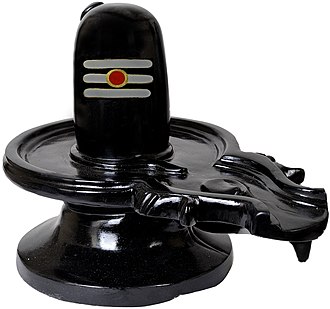
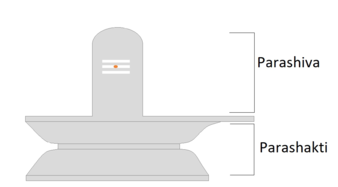




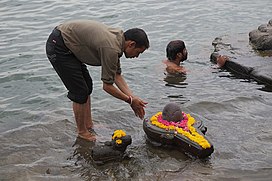


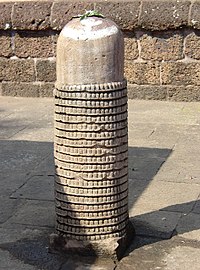


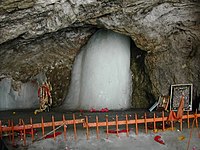
No comments:
Post a Comment